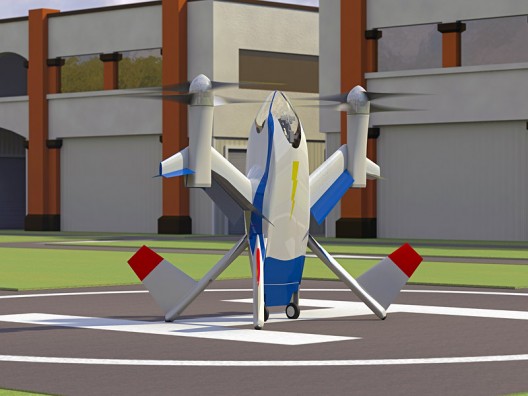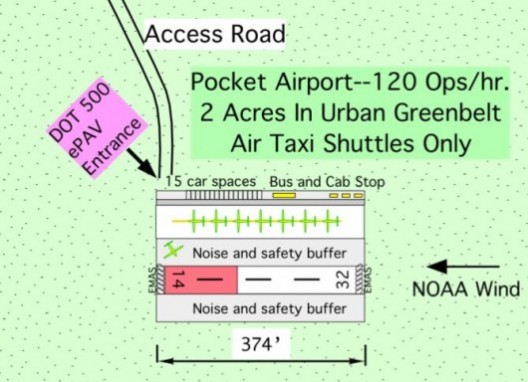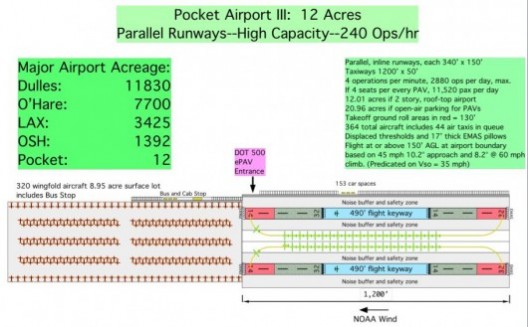The January 2011 issue of Popular Mechanics resurrects the perennial hope for a flying automobile. The cover taunts, “(Go Ahead, Laugh) But NASA, DARPA & the FAA Are Serious.” Sharon Weinberger taunts some makers a bit in her article, “Driving on Air,” as she looks at a variety of Transformer-style vehicles that can travel by land or air with the fewest inconveniences. She notes the differences between propelling cars and planes, and looks at extremely different modes of giving people personal aerial transport, including the Moeller Skycar (“Inventor Paul Moeller has been developing the concept for nearly 50 years. To date, the M400X has only hovered on a tether.”), the Martin Jetpack, The Cartercopter, and the Terrafugia Transition that’s been getting an enormous press following (and a featured spot in the Hammacher Schlemmer Christmas catalog) lately.
She ends with an overview of Dr. Mark Moore’s Puffin, detailed in this blog in January. After explaining that a commuter using the Puffin would rise relatively noiselessly out of his or her back yard, Weinberger turns to the problem of making the skies safe for the hundreds or thousands of such personal air vehicles (PAVs) that many would see as merely transferring traffic jams to a higher level.
“In Moore’s world,” she writes, “the nation’s airspace is open to unmanned aerial vehicles. In reality, the FAA has been reluctant to allow UAVs to share the sky with airliners, sport aircraft and helicopters. The Pentagon is leading the effort to draft the rules and define the technical standards that will open the nation’s airspace.
“Pressure is mounting to do so as federal and local agencies develop plans for using drones to monitor weather, provide tactical reconnaissance for police or conduct environmental studies. So commuting on a Puffin would be like hitching a ride on a UAV studded with collision-avoidance sensors and wired for direct communication with other aircraft and sensors on ground infrastructure.”
Such concerns are not only important in the U. S., but in Australia, where Richard Glassock and the Smart Skies program address issues including, “The development of leading-edge research platforms, sense-and-avoid systems, the automated separation management system, the mobile aircraft tracking system, development of simulation capabilities, and research into the development of UAS regulations and risk management.” Glassock, more than incidentally, is expected to address these concerns in a presentation at the fifth annual Electric Aircraft Symposium in Santa Rosa, California in April, 2011.
These reflect the requirements for making American skies safe, a major part of Dr. Moore’s plans for aircraft like the Puffin. He also sees a niche role for such PAVs, neatly fitted between the longest comfortable drive and the shortest practical commuter flight. As many who have frittered away their lives in security lines will attest, a fine line exists between the hours involved in getting on a half-hour flight and the coin toss that leads to a moderately long drive, fraught with all the hazards and literal roadblocks that entails.
Concluding his talk at the fourth annual EAS this year, Dr. Moore showed the viral video of the Puffin lifting vertically from its “launch pad” and whisking its commuter pilot to a destination. Not all PAV’s will be vertical takeoff and landing (VTOL) capable, however, and Dr. Brien Seeley, President of the CAFE Foundation, posits the pocket airport as a means to accommodate short takeoff and landing (STOL) PAVs. As shown in Gizmag’s coverage of Dr. Seeley’s talk at the recent Future of Electric Vehicles conference, these miniature flying fields could serve as a launching point for dozens of daily commuters.
Pocket airports could cover as little as two acres and handle 120 flight operations per hour and extend to 12 acres with four runways and 240 flight operations per hour. If each PAV carried the carpool equivalent of four passengers, up to 11,520 passengers could be shuttled off to work every day.
Neighborhood acceptance of either a personal liftoff from one’s own back yard or mass sorties from a nearby mini field requires a type of quiet electrically-powered craft that will radically change the face of private aviation. The supporting infrastructure will require equally radical rethinking of the rules of the air.
Drs. Seeley and Moore often seem to be tag-teaming the subjects of PAVs and how they will safely navigate future skies. Their continued alliance on these fronts could eventually lead to alleviation of the gridlock we now experience on the ground and in the air, and give us even greater personal mobility as we conveniently, quickly and quietly reach our destinations.





Comments 1
This article describes a vital step forward for PAVs and particularly electric planes. Several years ago I attempted to get my local council to start to look at the issue of local air access with very little success. In Sydney Aust we are loosing more local airstrips than we are gaining, and this further reduces the number of pilots in training. The problem is the value of real estate. Conventional runways, even small ones, require large areas which are viewed jealously by property developers as soft targets because of their low earning power.
Pocket airstrips are the best future alternative, and should be classed in the same category of public commons as roads, recognising the subsequent reduction in traffic loads and road routes. The challenge is to prove that air highways will not create an unbearable noise load on the public. Electric aircraft are the medium with which to achieve this. Mind you conventionally powered aircraft designers could help by not directing their engine exhausts (and consequently their engine noise) downwards and unmuffled.
In my original concept for the pocket airstrip I imagined something very similar to the first option, but sited alongside a straight stretch of local roadway preferrably in industrially zoned areas thereby shareing noise levels with road noise and offering a better chance of damage free engine failure landings.
Having failed to get any recognition from councils that they should be assigning some land for pocket airstrips I changed tack in the design of my aircraft. The formula that I have adopted is to build a hybride (wing design not power system) fully enclosed amphibious microlight. I chose an amphibious configuration because there is more open water space near all of the places to which I would like to fly than open land space. To achieve this I am designing a foldable deformable wing which transitions from a high speed low drag form to a high drag high lift form for landing by deforming the central section of the wing which very much resembles the landing configuration of the A380 wing. Coupled with a swashable pusher propellor this wing form creates lower pressure above the wing in landing configuration allowing a steeper approach angle (takeoff and landing) which in turn improves touch down point accuracy. The 3 seater fuselage is only 3.5 metres long and achieves some measure of Goldsmeid drag reduction with the aft fuselage shape which resembles an open ended NACA duct. In order to improve stability on the water the engine and fuel tanks are in the lowest part of the fuselage and as far aft as I could fit them which also moves the high wing further aft. The propellor is driven either by a longer than normal belt or a split shaft drive. If the 80 Kwhr 100Kg Lithium Polymer battery recently demonstrated in Germany on an Audi A2 is real then this configuaration will work as an electric aircraft as well as the current diesel design.
Having imagineered this configuation I then discovered by chance Waldo Waterman’s unbelieveable Aerobile which flew completely safely in 1937, making Waldo (in my opinion) one the greatest aviation geniuses of his time. A true aviation hero. My design is so similar it hurts to think about the loss of opportunity that his design was not widely adopted at the time. I have a flight simulator of his plane and it is a breeze to fly and so amazingly stable in the air.
So with the high folding wing (first fold down and the second up) my concept compacts to 3.5 metres long, 2.5 metres wide and 2.2 metres high (weight unknown at this stage), and fits very well into the pocket airstrip model proposed above.